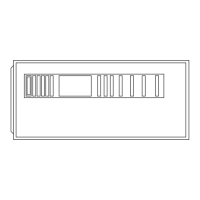openingmusthaveafleeareaofatleastI sqin,per1000Bmhof
totalinputratingbutnotlessthan100sqin.(See_able4.)
TaRe 4_Combustion Air
From Unconfined Space
FREE AREA PER
88CNA FURNACE
OPENING
INPUT BTUN
{SQ BN.)
70,000 100
91,000 100
t05,000 105
119,000 119
t40,000 140
154, 000 154
ALL AIR FROM OUTSIDE OF STRUCTURE
If outside air is supplied to a confined space, then the 2 openings
must be equal and located as above.
1. If combustion air is taken through a pem_anent opening
directly communicating with the outdoors, the opening shall
have a n_ininmm flee area of 1 sq in. per 4000 Bmh of total
input rating for all equipment in the enclosure.
2. If con_bustion air is taken from outdoors through vertical
ducts, the openings and ducts MUST have at least 1 sq in. of
flee area per 4000 Btuh of the total input %r all equipment
within the confined space. (See Table 5j
Table 5--Combustion Air From Outdoors
Through Vertica! Ducts
FREE AREA PER
58CMA FURNACE ROUND PIPE
OPENING
INPUT BTUN (SQ IN.} (BN. DIAI_4}
70,000 17.5 5
91,000 22.8 6
105,000 26.3 6
119,000 29.8 6
140,000 35.0 6
154,000 38.5 6
3. If combustion air is taken from outdoors through horizontal
ducts, the openings and ducts MUST have at least 1 sq in. of
fi'ee area per 2000 Btuh of the total input %r all equipment
within the confined space. (See Table 6j
Table 6--Combustion Air From Outdoors
Through Horizontal Ducts
58CNA FURNACE FREE AREA PER OPENING ROUND PiPE
INPUT BTUN {SQ IN.} (IN. DIAM}
70,000 35.0 7
91,000 45.5 8
t05,000 52.5 9
119,000 59.5 9
t40,000 70.0 10
184,000 77.0 10
When ducts are used to supply air, they must be of the same cross
sectional area as flee area of openings to which they connect
The mininmm dimension of rectangular air ducts must not be tess
than 3 in.
DLCT WORK RECOMMENDATIONS
When supply ducts carw air circulated by fi/mace to areas
outside spaces containing fi/rnace, return air MUST also be
handled by a duct sealed to furnace casing and tem_inating
outside space containing _/rnace. IncmTect duct work termi=
nation and sealing wilt create a hazardous condition which
could lead to bodily ham_.
Return=air grilles and warm air registers MUST NOT be
obstructed. Failure to follow this caution will result in
premature failure of the heat exchanger,
The proper sizing of warm air ducts is necessa W to ensure
satisfbctory furnace operation. Duct work should be in accordance
with the latest editions of NFPA=90A (Installation of Air Condi-
tioning and Ventilating Systems) and NFPA-90B (Wam_ Air
Heating and Air Conditioning Systems) or Canadian equivalent.
The supply duct work should be attached to flanged front opening
provided at discharge end of furnace. The return-air duct work
should be attached to flanged rear opening of furnace. See Fig. 2
for dimensions of these openings.
NOTE: The back (blower access opening) should not be used %r
remrn air.
The following recommendations should be followed when install-
ing duct work:
1. Install locking=type dampers in al! branches of individual
ducts to balance out system. Dampers should be adjusted to
impose proper static at outlet of _i/rnace.
2. A flexible duct connec[or of noncombustible material should
be installed at unit on both supply- and return=air systems. In
applications where extremely quiet operation is necessaw, the
first 10 f_ (if possible) of supply and return ducts should be
internally lined with acoustical material.
3. In cases where return=air grille is located close to fire inlet,
there should be at least one 90° air mrn between fire inlet and
grille. Further reduction in sound level can be accomplished
by installing acoustical air turning vanes or lining duct as
described in item 2 above.
4 When a single air grille is used, duct between grille and
ii/mace must be the same size as return opening in fire, ace
VENTING
Venting of filrnace should be to the outside and in accordance with
local codes or requirements of local utility-.
OIL=FIRED APPLIANCES SHALL BE CONNECTED TO
FLUES HAVING SUFFICIENT DRAFT AT ALL TIMES TO
ENSURE SAFE AND PROPER OPERATION OF APPLIAN(E.
For additional venting irKormation, refer to ANSIiNFPA 211
Chimney Fireplaces, Vents_ and Solid Fuel Burnino_liances
an&or CSA B139 Installation (7ode.
This fl/rnace is certified fbr use with Type "L" vent (maximum flue
gas temperature 575°F).
Vent System Inspection
Be[bre _i/mace is installed, it is highly recommended that any
existing vent system be completely inspected.
For any chimney or vent, this should include the following:
1. Inspection for any deterioration in chinmey or vent. If dete-
rioration is discovered, chimney n-rest be repaired or vent must
be replaced.

